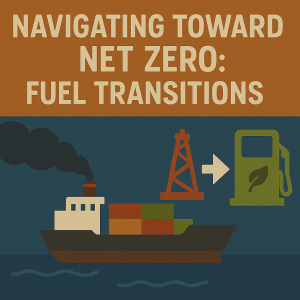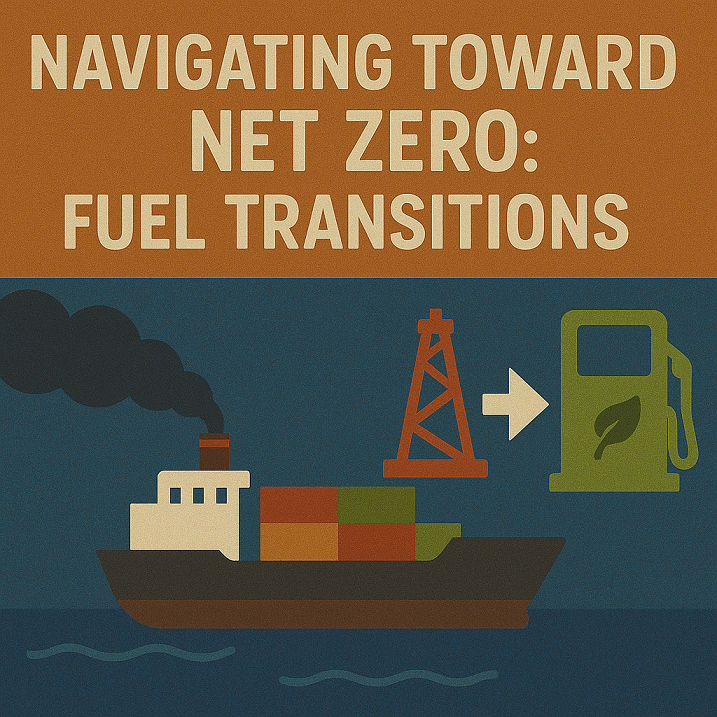Discover how the maritime industry is transitioning toward net-zero emissions. Explore the viability of alternative fuels, strategies for IMO compliance, and the role of digital tools in achieving sustainable shipping.
Why Green Shipping Matters in Modern Maritime Operations
 The world relies on ships to carry more than 80% of global trade, but this vital sector is also responsible for nearly 3% of global greenhouse gas (GHG) emissions, according to the International Maritime Organization (IMO). With the climate crisis intensifying, the pressure on the shipping industry to decarbonise is mounting.
The world relies on ships to carry more than 80% of global trade, but this vital sector is also responsible for nearly 3% of global greenhouse gas (GHG) emissions, according to the International Maritime Organization (IMO). With the climate crisis intensifying, the pressure on the shipping industry to decarbonise is mounting.
The maritime sector has long been seen as a hard-to-abate industry due to its dependence on fossil fuels, long vessel lifespans, and the complex global regulatory environment. However, the tide is turning. The revised IMO GHG Strategy (2023) now targets net-zero emissions around 2050, with checkpoints in 2030 and 2040. This signals a new era where fuel choices, vessel designs, operational strategies, and digitalisation must align toward sustainability.
But what fuels will lead the charge? How are companies adapting? And can shipowners afford the green transition, or can they afford not to?
Exploring Viable Alternative Fuels: Present and Emerging Options
Liquefied Natural Gas (LNG): A Transitional Fuel?
LNG remains one of the most adopted alternative fuels, with over 400 LNG-powered ships in operation globally as of 2024 (DNV Alternative Fuels Insight). It offers significant reductions in SOx, NOx, and particulate matter, and up to 20% less CO2 emissions compared to heavy fuel oil (HFO).
However, critics argue LNG is not a long-term solution due to methane slip — the unburned methane released into the atmosphere, which is a potent greenhouse gas. The ICCT warns that without advanced methane abatement, LNG could actually worsen the industry’s climate footprint in the long run.
Methanol: Gaining Momentum
Methanol, particularly green methanol (produced using renewable electricity and captured CO2), is quickly gaining ground. Maersk ordered 25 dual-fuel methanol vessels between 2023 and 2025, showcasing confidence in its scalability. Methanol is easier to store than LNG and can be used in modified internal combustion engines.
Still, availability remains limited, with green methanol production covering less than 0.5% of global demand as of 2023 (IEA Methanol Report). Scaling up will require massive investment and clearer regulatory signals.
Ammonia: A Zero-Carbon Promise with Safety Concerns
Ammonia, containing no carbon, offers a path to zero CO2 emissions at combustion. It’s already widely traded as fertilizer, and major players like Mitsui OSK Lines, NYK Line, and Wärtsilä are actively testing ammonia-fueled engines.
However, ammonia is highly toxic and poses serious health and environmental risks if leaked. Infrastructure and safety protocols are in early stages, and classification societies like ClassNK and ABS are still finalising fuel guidelines.
Hydrogen: Clean but Challenging
Green hydrogen (from water electrolysis using renewable power) is arguably the cleanest option. But hydrogen’s low energy density and need for cryogenic storage (below -253°C) make it difficult for long-haul shipping.
According to Lloyd’s Register, hydrogen may be more suitable for short-sea or auxiliary applications unless onboard storage technologies evolve drastically.
Biofuels: Drop-In and Ready, But Not Scalable
Sustainably sourced biofuels (e.g., hydrotreated vegetable oil) can be used in existing engines with little modification, making them attractive in the short term. Trials by Maersk, MSC, and Hapag-Lloyd have shown positive results.
Yet, feedstock availability, land use concerns, and inconsistent quality control limit scalability. The International Energy Agency (IEA) notes that maritime-grade biofuel supply will need to increase 10-fold to meet 2030 decarbonisation pathways.
Shipping Industry Adaptation to the IMO’s Green Mandate
From Compliance to Leadership
The revised IMO Strategy on GHG Emissions Reduction aims for:
- 20–30% GHG reduction by 2030 (compared to 2008 levels)
- 70–80% reduction by 2040
- Net-zero GHG emissions by ~2050
To meet these targets, shipping companies are moving from a compliance mindset to proactive leadership. This includes investing in dual-fuel vessels, forming green shipping corridors, and participating in carbon pricing pilot programs.
CMA CGM, for instance, has committed USD 10 billion through 2026 for low-carbon fleet renewal, fuel partnerships, and R&D. Similarly, NYK Line is rolling out its “Sail Green” program to track carbon performance on individual voyages.
EEXI, CII and Beyond
New IMO regulations such as Energy Efficiency Existing Ship Index (EEXI) and Carbon Intensity Indicator (CII) are already in effect, influencing ship designs and operational speeds. The Paris MoU has begun inspections based on CII ratings, flagging underperforming vessels.
DNV’s 2023 Maritime Forecast shows that over 55% of existing ships will need technical or operational upgrades by 2030 to maintain compliant CII scores.
The Cost of Compliance: Preparing for Green Retrofitting
Financial Realities
Retrofitting ships for alternative fuels or improved efficiency is not cheap. Installing LNG or methanol dual-fuel engines can cost between USD 8 million to USD 15 million per vessel, depending on ship type, according to Clarksons Research.
Even smaller retrofits, such as energy-saving devices (ESDs), hull coatings, or propeller upgrades, involve significant capital. Many shipowners face a dilemma: upgrade now or risk future regulatory or commercial exclusion?
To help finance the transition, the Poseidon Principles and the Sea Cargo Charter are aligning investment decisions with IMO targets. Green finance tools such as sustainability-linked loans and carbon-offset-linked charters are becoming more common.
Long-Term Payback Through Operational Savings
Fuel-efficient ships may cost more upfront but save millions over their lifespan through reduced fuel consumption and emissions penalties. Case studies from The Royal Institution of Naval Architects show that retrofits like air lubrication systems and wind-assist sails can deliver 5–15% fuel savings.
Still, financing remains a major hurdle for smaller operators. Industry bodies like ICS and BIMCO continue to advocate for global carbon funds to support developing nations and small fleets.
The Role of Digital Tools and Voyage Optimization in Decarbonisation
Big Data and AI for Smart Voyage Planning
Optimising voyages isn’t just about taking the shortest route. Today’s digital platforms can model weather, currents, congestion, and even regulatory zones to propose routes that cut both time and emissions.
Platforms like Wärtsilä Voyage’s Navi-Planner, Navtor, and Inmarsat Fleet Data use AI to suggest fuel-saving speed profiles and optimal departure times. According to Thetius Research, such tools can cut fuel use by 5–10% on average.
Condition-Based Maintenance
IoT-enabled sensors onboard vessels now allow for condition-based maintenance rather than fixed schedules. This improves engine reliability, reduces unplanned downtime, and minimises unnecessary port calls.
Shell Shipping & Maritime reported a 12% drop in maintenance costs and a 7% improvement in voyage efficiency after deploying smart analytics across its tanker fleet.
Real-Time Emissions Tracking
Digital twins and smart monitoring systems allow shipowners to measure emissions in real-time and adjust operations accordingly. These tools help ensure compliance with CII and EU ETS tracking, while enabling better carbon accounting.
For example, ABB Ability™ Marine Advisory System – OCTOPUS provides holistic voyage analytics, helping operators stay within carbon thresholds while optimising fuel spend.
Case Studies: Leading the Green Voyage
- Maersk: Operating the world’s first methanol-fueled containership in 2023; building green fuel partnerships with European and Asian suppliers.
- Yara Clean Ammonia & Enova: Building the world’s first ammonia bunkering hub in Norway, launching in 2025.
- Cargill & BAR Technologies: Fitting wind-assisted sails (WindWings) on bulk carriers to cut emissions by 30%.
- Port of Rotterdam & Port of Singapore: Partnering to develop the first green shipping corridor focused on hydrogen and methanol transitions.
FAQ
What is the IMO’s net-zero goal for shipping?
To achieve net-zero GHG emissions by around 2050, with interim checkpoints in 2030 (20–30%) and 2040 (70–80%).
Which fuel is the best alternative today?
There is no single best fuel. LNG, methanol, and ammonia each offer benefits and challenges. Fuel choice depends on route, vessel size, and operational needs.
Are green retrofits worth the cost?
Yes, in the long run. Fuel savings, regulatory compliance, and commercial attractiveness increasingly depend on sustainability performance.
Can digital tools really reduce emissions?
Yes. AI-based voyage planning, real-time monitoring, and condition-based maintenance can cut fuel use and emissions by 5–15%.
Will smaller shipping companies be left behind?
Only if action is delayed. Green finance, shared bunkering infrastructure, and digital platforms are becoming more accessible.
Conclusion
The green shipping transition is no longer a future ambition — it is the new standard. The journey toward net-zero emissions will be complex and costly, but it offers not only environmental benefits, but also operational and economic advantages.
From methanol-powered megaships to digitally optimized voyages, the industry is evolving. However, real success will require collective action across governments, class societies, port authorities, and shipping companies. Those who prepare early will sail ahead. Those who delay risk falling behind.
In this decisive decade, shipowners and maritime professionals must embrace alternative fuels, invest in digital innovation, and adopt sustainability as a business imperative. The course toward net zero is set. Now it’s time to navigate it.
References
- IMO Revised GHG Strategy 2023
- DNV Maritime Forecast 2023
- Clarksons Research Maritime Outlook
- IEA Methanol Report
- BIMCO Regulatory Watch
- Wärtsilä Voyage Navi-Planner
- Shell Shipping Maritime Annual Report
- Thetius Smart Shipping Insights
- Poseidon Principles
- Maersk Green Methanol Fleet
- Sea Cargo Charter
- Paris MoU CII Inspections
- ABB OCTOPUS System

